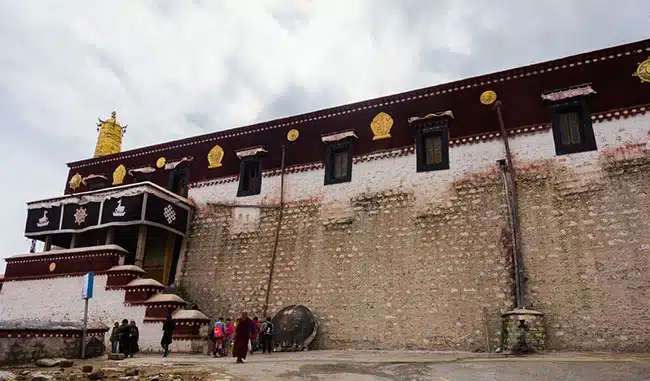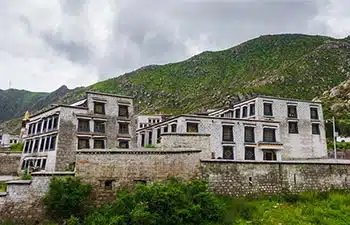Drepung Monastery is one of the Six Great Monasteries of Gulug(Yellow Hat) in Tibet, and shares the fame of the Three Great Monasteries in Lhasa with Sera Monastery and Ganden Monastery. It locates at south side of Gebeiwoze Mountain, 10km east of west suburban of Lhasa city. The ordered architectures in white was built against the Gebeiwoze Mountain and fully occupied the hillside, seeming a huge rice dump, hence the name of “Drepung” which means collected rice in Tibetan language and represents the prosperity of Tibetan.
The first founder of this monastery is Jamyang Qoigyi Zhaxi Bendain, a disciple of Gulud School’s founder Tsongkhapa, who built Drepung Monastery in 1416, the period of Ming Dynasty with the assistance of a Tibetan lord. Most of architectures in this monastery were built in Ming and Qing Dynasties, mainly including 6 Assembly Halls and 4 Dratsangs and 29 Khangtsens, which made Drepung Monastery the largest scale among all monasteries in the Tibetan region. Owning 141 manors and more than 540 farms, kept more than 10,000 monks had been lived and studied here, Drepung Monastery earns its highest status in Tibetan Buddhism. It also has been the mother monastery for the all Dalai Lamas.
The Coqen Hall occupies a central status in the Drepung Monastery from both location and position. It covers 4500m2, and has 4 floors in total. There is a square with 200m2 in front of the Coqen Hall, so the travelers need to walk through the square and climb 17 steps to the bright gallery with 8 columns of the Hall. There are 221 rooms and 183 columns of the inner Hall which occupies about 1800m2. The whole hall has been decorated into the typical Tibetan style with bright religious flags, paintings Buddha images, seeming grand and magnificent. The second, third and the last storey are mainly to place some important Buddhist sutras, Buddhist images and the statues of Sakyamuni at the last storey.

Except the Coqen Hall, the Ganden Potrang is another important Hall in Drepung Monastery. It is a independent building at the front left of Drepung Monastery constructed by the second Dalai Lama in 1530, styling in ancient castle. After the second Dalai Lama, all the third to fifth Dalai Lama had lived here when they were the abbots of Drepund Monastery. It had built the strong politic power in this monastery during the time of fifth Dalai Lama and had been the politic center of the whole Tibet some time, hence won its fame. Later the fifth Dalai Lama had moved to the Potala Palace to deal with affairs.
Then is the Dratsang, the first management organization under the Coqen Hall. There were 7 Dratsangs at the first time and then combined into the present 4 ones, which could devided into two sorts according to their functions: one is the chanting hall for assembly of monks and another is for store and worship the Buddhist images. The next class after the Dratsang is Khangtsen for monks to live and study.
As the monastery keeping the largest scale and highest status in Lhasa, Drepung Monastery also has plentiful treasures in its store. The famous fine chinaware of many different dynasties dates back to Song, Ming and Qing time. Hundreds of Thangkas are hanging in the halls of Drepung Monastery, thousands of Buddhist images or statues are worshipped here and abundant deliberate Tibetan style decorations adorn the monastery. And it even has kept many ancient weapons and armor which provide the important date for today’s people to learn the Tibetan culture, history and military.
Drepung Monastery has been the major battle of Shodon Festival in the late June and early July in Tibetan calendar. At the very beginning, Shodon is a pure religious activity in only Drepung Monastery. Later, this festival gradually expanded its effect in the whole Tibetan region and grew into today’s scale and position in Tibet. Besides the original religious items, Tibetan operas, dancing and songs has been added into this significant festival, which leads the Shodon Festival, especially in Drepung Monastery, to be the most well-known religious and art festival today.

Open Time: 9:00-16:00
Entrance charge: CNY50
Travel Tips:
- The famous Shodon Festival is in the late June and earlyJuly in Tibetan calendar to show the unique Tibetan art and religiousappeal. Visitors also can visit here to feel these on that day.
- Travelers should obey and respect the customs and rules of Tibetan Buddhism, walk clockwise round the monastery, halls and when in the pilgrim circling.
- Visitors should respect religious belief of local peopleand not point the Buddhistimages with fingers. Taking caps off, keeping quiet and taking no photos here.
- Travelers are suggested to visit halls of the monastery in the morning and noon becausemany of them would close in afternoon. Then people could speciallyenjoy debate starting from 2:30 pm in the afternoon.
- Keep quiet when watch thedebate or take photos of and keep some distance from the monks so as to avoid disturbing them.
- Sera Monastery bears high altitudes so the new comers need to be careful and not cause the altitude stress
- Most monks in Drepung Monastery are friendly and easy-going. If fortunately, travelerscould ask some monks to have an explanation about the knowledge of this monastery.










